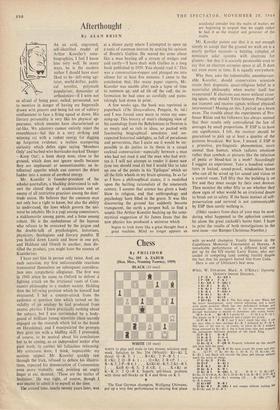Chess
By PHILIDOR No. 205 A. ZARUR (Hon. Men., Nanning Tourney, 1959)
BLACK (10 men)
WHITE (10 men)
WHITE to play and mate in two moves; solution next week. Solution to No. 204 (VVhyatt): Kt—Kt 2, threat Q—K 3. 1 . . B xKt; 2 P—B 3. 1 . . . RxKt; 2 Q—B 4. 1 . . . QxKt; 2 RxP. 1 ... B—K 5; 2 P—B 4.1 . . . Kt(Kt 4)—K5; 2 Kt—B 3. 1 . . Kt(B 4)—K 5; 2 RXR. 1 ... KXKt or K—i..5; 2 Q—B 4. Superb, self-block problem with three self-blocks on K 4 and three on K 5.
The East German champion, Wolfgang Uhlmann, put up a very fine performance in sharing first place
with ex-world champion Vassily Smyslov in the Capablanca Memorial Tournament at Havana. A remarkable performance of a different kind was put up by the US master Larry Evans, who suc- ceeded in competing (and coming fourth) despite the fact that his passport barred him from Cuba.
Here is one of Uhlmann's best wins.
White, W. UHLMANN. Black, A. O'KELLY. Opening, QUEEN'S INDIAN DEFENCE.
1 P—Q 4 111—KB 3 2 P—QB 4 P—K 3 3 Kt—KB 3 P—QKt 3 4 Kt—B 3 11—Kt 2 5 B—Kt 5 P—KR 3
6 B---R 4 P—KKt 4 '7 B—Kt .3 • KI—R 4
8 Q—B 2 KIX11 9 RP X Kt B—Kt 2. The first stage is aver White has
the better development, some central advantage and a MOI0 solid pawn position; Black has two well-placed bishops and potentially the better endgame. A lot of practical testing through masterpluy is needed to determine who stands better. 10 0-0-0 ICI—B 3. 1 prefer 10 P—Q 4 or P—Q 3. The knight on B 3 is misplaced and a target for attack. 11 P—K 3 P—R 3 and I don't much like this; I an, not sure what is best—perhaps Kt—K 2 followed by p—Q 4. The idea of the text is, of course, to allow Q—K 2 without being annoyed by Kt—Kt 5, but it both loses time and weakens
the subsequent defensive position of the black King. • 12 P—R 3 Q—K 2 13 B—K 2 0-0-0 14 P—Q 51 Kt—R 2 15 Kt—Q 4 P—QB 41 Properly followed up this should just have held the game.
16 P—Q 61 Q—B 1? He must accept the pawn and MO 16 . . . Q x PI; 17 Kt (4)—Kt 5, Q--K 2!; 18 Kt XKt K—Kt I and Black will recover the' piece and emerge without much the worst of things.
17 Q—Kt 31 P X Kt 18 Q X P K—lit 1 19 B-11 3 Kt—B 3 20 111-11. 4 K--R 1 21 Kt-11 5 R—QICI 1. 21 . . . B—B I; 22 ‘KtXRP;
B XICt; 23 Q X B ch, K--Kt I; 24 Q—Kt 6 ch, K—R 1; 25 P-132, followed by R—Q 3—Kt 3 winning (25 . . . R—QKt 177; 4° Q—R 6 mate).
' 22 Kt X RP R—B 1 •
23 Kt—B 5 .R—QKt 1 and resigns without waiting 10° 24 B XKt and 25 Q—R 5.


































 Previous page
Previous page